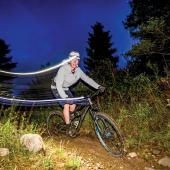Down the Yellowstone, Up the Missouri
Following the paddlestrokes of Lewis and Clark.
"In the beginning of this record I tried to explore the nature of journeys, how they are things in themselves, each one an individual and no two alike. I speculated with a kind of wonder on the strength of the individuality of journeys and stopped on the postulate that people don’t take trips—trips take people.” —from John Steinbeck’s Travels With Charley
It was a warm August afternoon in Bill Bartlett’s law office in downtown Bozeman, and as I sat down with Kay Ruh and her husband Bill I could immediately feel the balance of their relationship. Longtime paddlers, they had just completed a journey that led them, over the course of nine years, downstream from Livingston to the mouth of the Yellowstone and then upstream on the Missouri river 800 miles against the grain to finish on the exact same day, 200 years later, as the Lewis and Clark expedition arrived at the Headwaters. Bill’s eyes sparkled with excitement and his voice held much emotion and passion for adventure, discovery, and a life enriched with as much “playtime” as he can squeeze into the folds, cracks, and crevasses. Kay, with her warm demeanor, was a good balance to Bill’s gung-ho enthusiasm, for through her measured mannerisms came a clear, rationale and steadfast resolve that would surely outwit and outlast any Survivor contestant. I immediately decided that if I ever undertook an adventure race, I wanted these two on my team.
Sleep Tandem, Paddle Solo
Kay and Bill hold impressive paddling résumés. Kay’s first canoe trip was a six-week, 600-mile journey in the Northwest Territory in 1979. With 600 pounds of gear, three canoes, and 63 double- and triple-portages, it was one heck of an introduction. Bill came into paddling as a stress-reliever from studying for the bar exam and found a true love through every stroke of his paddle. He eventually built his own canoe with the help of a friend and embarked on a two-week trip on the Churchill River. Kay and Bill began their life on the water together in 1993 and jumped into adventuring together on the lakes and rivers of the West with invigorating enthusiasm. “Nineteen ninety-four was a busy year,” Kay muses as she recounts an interesting trip in Glen Rim Canyon in Escalante, Utah. Despite maneuvering their boat and gear down 800 vertical feet of slippery slick rock in just a quarter of a mile, Bill’s bout with food poisoning from an unfortunate Navajo taco, and drenching rain showers, they still smile and laugh as they describe breathtaking waterfalls and how duct tape truly is man’s best friend. In September of 1999 the couple journeyed to the Boundary Waters in upper Minnesota, to a land of a thousand lakes and a thousand-and-one portages, and were married in their respective solo canoes, in the environment that had carried and fed their relationship.
Didn’t Miss a Mile
Paddling upstream 800 miles seems like such a mammoth accomplishment to someone on the outside. “It’s just what we do,” says Kay. “It’s a part of who we are, and we don’t think of it as work. It’s not until we sense the excitement and wonder in others do we finally look back and realize what we’ve just accomplished.” Her honest and straightforward comments are a good metaphor for how they navigated the Missouri: head-on. Due to the unfortunate realities of juggling “real-life” responsibilities with their outdoor passions, they paddled the Missouri in stretches. Ranging from long weekends to a week at a time, they squeezed in as many miles as they could before the wind was simply too strong or vacation days ran out.
Their biggest challenge was the wind. They were on the water by six-thirty every morning, getting as many paddle strokes in as they could before the wind halted their progress altogether. Kay and Bill were forced out of their boats in some sections, which Kay approximated to about a third of the entire trip. If paddle strokes are no longer efficient, a technique called “lining” (towing your boat along with you while you walk along the shore) is a major energy-saver in certain conditions. Lewis and Clark used the same method; however, their terminology was “cordelling”. The pair even made it through the challenging rapids near the Maroney Dam, despite the river’s attempt to take away both Bill’s Tevas and his boat in separate instances.
Kay remarked that paddling upstream into a headwind educated her immensely about water’s hydraulics and nuances, and made her a much more efficient paddler. They became a well-oiled machine, drafting each other to share the water and wind resistance, developing efficient paddle strokes, and even following a carp’s wake in search of the path of least resistance. Bill described this gift of cooperation and teamwork best: “It put glue in our relationship the hard way.”
Don’t Leave Your Boat on the Ramp
Eastern Montana seemed like their own private universe. With limited river access and sparse population, people were not the norm. Bald eagles, blue heron, pelicans, sandhill cranes, beaver, deer, elk, and the occasional rattlesnake were their companions on this leg of the expedition. Life beyond their tiny tent and backpacking stove seemed like a distant memory. Upon completing one idyllic week-long section, they reached the take-out at Fourchette. Vehicles, ATVs, RVs, and people became more and more prevalent, jarring Kay and Bill back into the land of the living, seemingly light years away from where they’d just been. While dragging their canoes and gear up the side of the boat ramp, Kay and Bill noticed a truck roaring into the parking lot, motorboat in tow. As Kay retrieved their own car, Bill watched in horror as the driver backed down the ramp, throwing gravel and dust in its wake. “It’s not polite to leave your boat on the ramp,” he belted out the window, and proceeded to run over Kay’s canoe. Twice. Gear and pieces of her beloved boat were scattered all over the take-out and into Fort Peck reservoir. This was the boat Kay was married in, the boat she had bought with Bill years before, the boat that had carried her safely through so many different waters, the boat that was destroyed haphazardly before Bill’s helpless eyes. Through a tear-streaked face Kay said to the thoughtless boater, “That is the meanest thing anyone has ever done to me.”
Finished? Not by a Long Shot
For Bill, the element of adventure left the trip as they reached Great Falls. More houses, more people, more boats. The wild and scenic portion of the Missouri had been like stepping back in time, seeing what Lewis and Clark had seen 200 years before, while traveling in the same manner they did. Now, from Great Falls to the Headwaters, Bill and Kay remarked at the beauty of Canyon Ferry and other famous landmarks along the way—but they were no longer in “America’s Serengeti.” On July 27, 2005 the couple ended their journey at the modest boat ramp near Trident, Montana. Bill greeted friends and family with, “Welcome everyone. It’s been a long time getting here.” Several weeks later, Bill is already scheming for his next adventure, which is tentatively planned as a trip on the Missouri from the Headwaters to St. Louis, Missouri. Kay agrees: “I’m ready to go downstream for awhile.” She now has a new boat, an extremely light carbon-fiber Wenona Prism, and while the loss of her first boat is still with her, it did not sour her experience or journey. She ribs Bill for breaking her new lightweight (eight ounces!) paddle, and describes their adventure with a smile as “so special and meaningful.”
Most people living in Bozeman are drawn here for a quality of life outside of the normal. To be able to walk out their front doors and be minutes away from trails shrouded in wild flowers, blue-ribbon trout streams, bottomless powder, and perfect, clean granite cracks—this is something to be treasured. Perhaps Bill Bartlett and Kay Ruh began this adventure as simply a place to go to do something they love. However, what they have come away with can’t be captured with a camera or saved among the pages of a favorite book. Only those who have journeyed for the sake of journeying can understand that the joy of any trip is not where you go, but how you get there.
From Bill Bartlett's Journal:
6/18/00 - This day has brutalized me. I sit in the Missouri Breaks truck stop at 1:00 pm. The room is swimming with my vertigo, caused by four hours of bobbing about in a turmoil of waves.
The wind is making me crazy. It beats on me and screams at me without a break. I’m constantly vigilant against any unusual waves or snags in the water as I skip across the water sideways. It is not a peaceful downriver run, it’s a battle zone and my only weapon is a downriver low brace.”
6/16/01 - ALONE AGAIN - JUST ME AND THE WIND
6/17/01 - The river is full of debris. As I write a thirty-foot tree goes by with a root ball two feet in the air. Probably saw two dozen pieces of timber over fifteen feet long.
6/19/01 - Parts of this day found me thinking bad thoughts. Now the wind’s down and mosquitoes are mildly troublesome but I’m no longer suicidal.
7/19/01 - I feel physically and, to my surprise, psychologically recovered. But then, I didn’t have any idea what such a physical commitment could do to my mind. Absolute commitment to only one goal, a physical goal, sustained throughout every available minute.
I look back on the last month and see that I experienced an emotional and mental depression along with my physical depression and when it comes to emotional stuff you look back at where you’ve been but you never really know where you’re at. I think I’m recovered.
5/23/03 - Take the time to run down a list of what can go wrong and before long the one thing you need right – attitude – is wrong.












